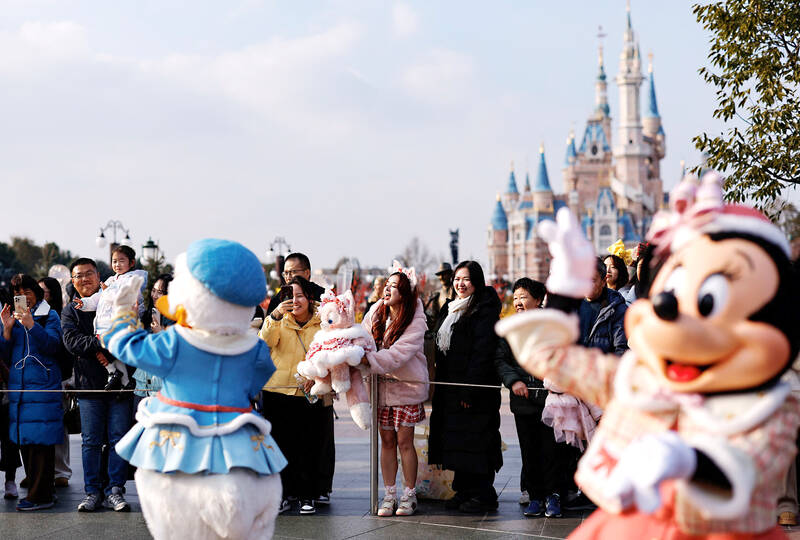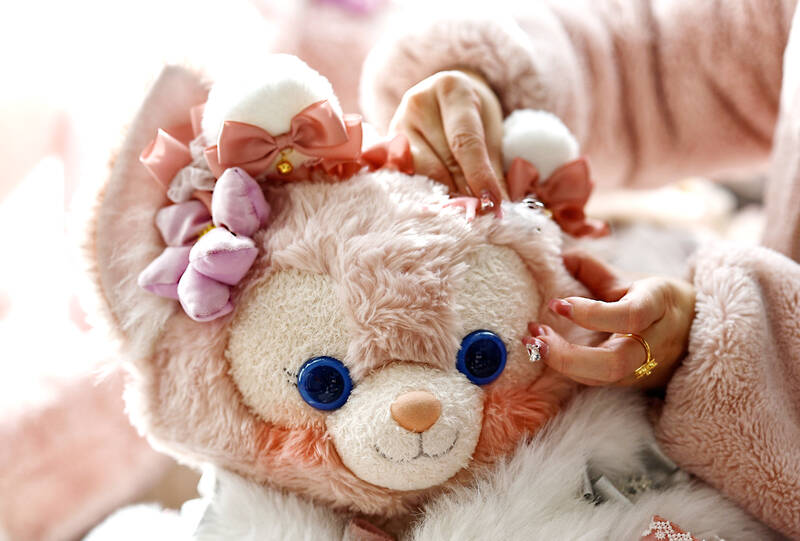Each week, whenever she has time off from her marketing job, Ida Jia can be found at Shanghai Disneyland queuing for hours to spend a few minutes with Linabell, a fluffy pink fox with big blue eyes.
The 29-year-old does not go empty handed, bringing pink fox soft toys dressed in ornate custom-made outfits to show the life-sized character, as well as handmade presents as gifts.
Linabell, which made its debut in Shanghai in 2021, is helping Disney benefit from a rapidly growing market in China for merchandise related to toys, games, comics and anime, which remained popular with teenagers and young adults throughout the last year, even as they reduced spending on items from beauty products to luxury handbags.

Photo: Reuters
The phenomenon has been dubbed “emotional consumption” in Chinese state media, and has been likened to the so-called “lipstick effect” in which consumers seek out more affordable luxuries as the economy languishes.
Jia first met Linabell at Shanghai Disneyland three years ago and says she felt an immediate connection with the character. In the years since, she has transformed her home and bedroom with Linabell merchandise.
“She has a positive influence on me, feeling her cuteness and energy is very soothing,” she said during a recent trip.

Photo: Reuters
Jia is far from alone in China in her devotion to Linabell, which has gained a large following since it was created as part of the Duffy and Friends series of characters — which also includes teddy bears, a bunny and a turtle.
Linabell, which has since been introduced at parks in Hong Kong and Tokyo, is arguably Disney’s most popular character in China, attracting at least as many fans as Mickey or its Disney princesses. Many adults, mainly young women, join daily queues to see Linabell, wanting to get a hug and take home a selfie as a souvenir from their day at Disney.
Alongside Linabell and Duffy and Friends, which have their own dedicated boutiques inside Shanghai Disneyland, others that are benefiting from the trend include collectible toy brands such as Jellycat and Chinese blind box toy retailer Pop Mart whose Labubu rabbit-like character sparked a global craze.
“They are filling an emotional void, the products are there to remind themselves that you can be happy about the little things in life,” said Yaling Jiang, founder of research and strategy consultancy ApertureChina.
“I do believe it’s related to the economy.”
According to Sami Wong, a psychotherapist and managing director of 3Drips Psychology, a research firm, the growth of emotional consumption in China is also part of the evolution in younger consumers’ behaviour away from purchasing goods simply as a status symbol.
“It’s really about understanding themselves and how to get in touch with their internal needs so they can establish an identity that feels consistent and coherent with their sense of self,” she said.
Xia Sansan, 28, along with her husband Rooney Sheng, are the proud owners of what they believe is the world’s largest collection of Duffy and Friends merchandise, having bought every single item released by Disney in Shanghai, Hong Kong and Tokyo.
Their 100-square-metre apartment in Shanghai is crammed with their collection of thousands of toys arranged in floor-to-ceiling cabinets, alongside racks of headbands, bags, keychains and more. Xia estimates they have spent more than 1 million yuan (US$136,000) in total.
“I mainly consider the emotional value when I consume,” Xia said.
“The value comes from seeing so many dolls at home every day, which makes me very happy, it’s this kind of healing feeling,” Sheng added.
Yasmeen Chen, creative director of merchandise at Shanghai Disney Resort and part of the team that created Linabell, said the character’s popularity had exceeded their expectations and that she had the potential to find success beyond Asia.
“These days everyone is looking at their phones and using computers; the interaction between people is less and sometimes there may be less companionship with parents, friends or family,” she said.
“I think in this regard, Linabell and Duffy and Friends provide a lot of emotional value.”

In 1990, Amy Chen (陳怡美) was beginning third grade in Calhoun County, Texas, as the youngest of six and the only one in her family of Taiwanese immigrants to be born in the US. She recalls, “my father gave me a stack of typed manuscript pages and a pen and asked me to find typos, missing punctuation, and extra spaces.” The manuscript was for an English-learning book to be sold in Taiwan. “I was copy editing as a child,” she says. Now a 42-year-old freelance writer in Santa Barbara, California, Amy Chen has only recently realized that her father, Chen Po-jung (陳伯榕), who

Famed Chinese demographer Yi Fuxian (易富賢) recently wrote for The Diplomat on the effects of a cross-strait war on demography. He contended that one way to deter the People’s Republic of China (PRC) is by putting the demographic issue front and center — last year total births in the PRC, he said, receded to levels not seen since 1762. Yi observes that Taiwan’s current fertility rate is already lower than Ukraine’s — a nation at war that is refusing to send its young into battle — and that its “demographic crisis suggests that Taiwan’s technological importance will rapidly decline, and

Jan. 6 to Jan. 12 Perhaps hoping to gain the blessing of the stone-age hunter-gatherers that dwelt along the east coast 30,000 years ago, visitors to the Baxian Caves (八仙洞) during the 1970s would grab a handful of soil to bring home. In January 1969, the nation was captivated by the excavation of pre-ceramic artifacts and other traces of human habitation in several caves atop a sea cliff in Taitung County. The majority of the unearthed objects were single-faced, unpolished flake tools fashioned from natural pebbles collected by the shore. While archaeologists had found plenty of neolithic (7,000 BC to 1,700

These are volatile times for the Taiwan People’s Party (TPP), with the party’s founder, Ko Wen-je (柯文哲), in and out and back in jail repeatedly, Ko resigning as party chair and naming TPP caucus convener Huang Kuo-chang (黃國昌) to replace him and an upcoming party leadership vote. How representative of the party’s supporters has the party’s leadership been recently? The TPP caucus in the legislature is so closely aligned — and votes so similarly to — the Chinese Nationalist Party (KMT) that they are in effect a pan-blue party now. Billing themselves as the “white force” between the pan-blue and pan-green